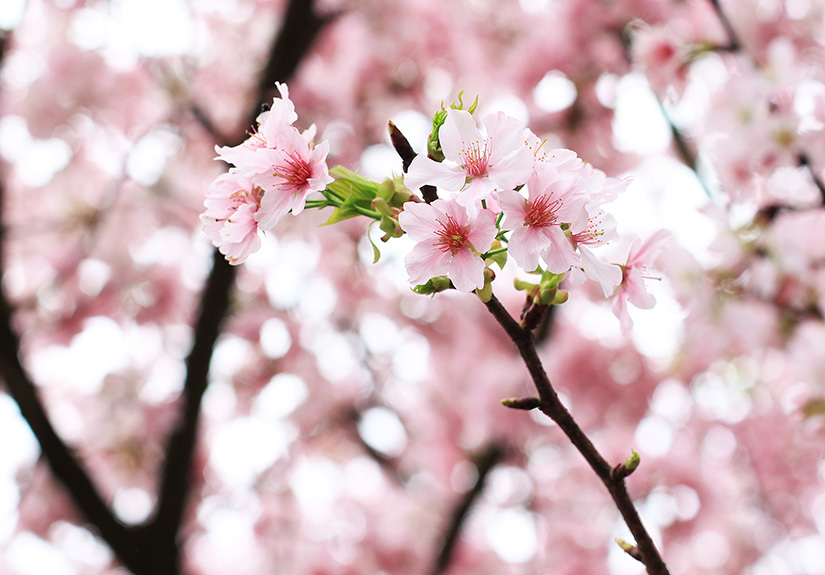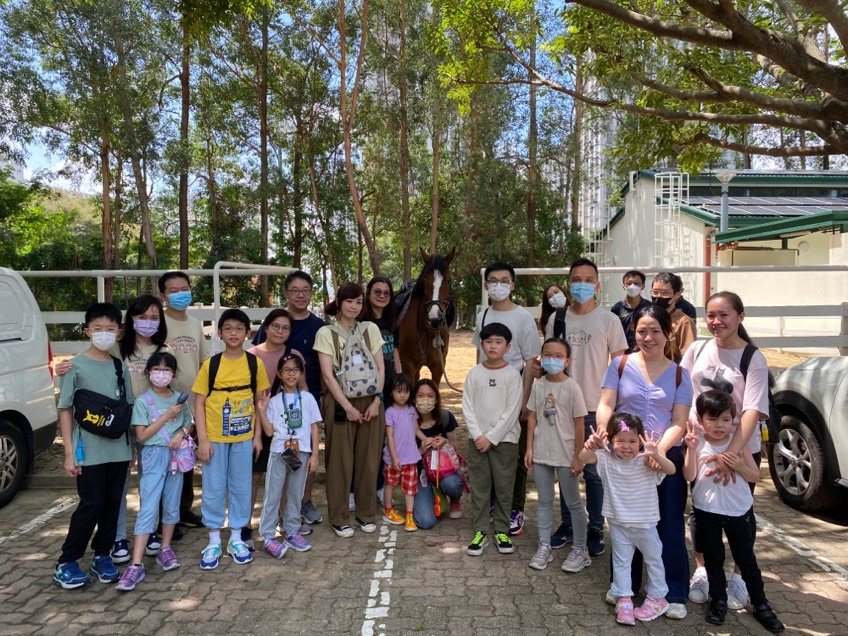Top Three Flower Photography Destinations In Northern Kanto, Japan
Sakura trees lining along streets and riverbanks are typical romantic scenery of the authentic Japanese Spring. In fact, many of the famous flower viewing locations can be found in the Northern Kanto Region, including Hitachi Seaside Park which is highly praised by flower lovers as the must-go destination to see Japan’s most beautiful flower fields. Check out the three famous flower viewing locations recommended in this article and put them into your travel list this Spring and Summer!

Transportation to Northern Kanto
Tokyo is, without question, the most popular travel destination among Hong Kong people. Ibaraki Prefecture, Tochigi Prefecture and Gunma Prefecture which are in the same Northern Kanto Region as Tokyo are relatively less popular but offer many good places for flower viewing. The three destinations recommended by photographer Arnold Lee are accessible by public transportation such as high-speed buses and JR trains from Tokyo. However, Arnold prefers hiring a car to go as this can save much time on transportation and makes the itinerary more flexible. “We can base in Tokyo for a 7-day trip, and take like two days to visit Ashikaga and Ibaraki Prefecture. Day trip is not suggested as it’ll be too rush for shooting.”

Locations of the three flower viewing spots
Source: Google Map
Source: Google Map
Hitachi Seaside Park
Address: 605-4 Onuma-aza, Mawatari, Hitachinaka, Ibaraki
Opening Hours (Spring and Summer): 9:30am - 5pm
Access:
Opening Hours (Spring and Summer): 9:30am - 5pm
Access:
- Take JR Joban Line from Tokyo Station to “Katsuta Station” and then taxi
- Take High-Speed Bus “Katsuta Tokai Line” from Tokyo or Ueno Station to the park directly

A fascinating scenery of the baby-blue-colored sea of flowers under a blue sky
Photo by Arnold Lee
EOS 5D Mark III • EF 16-35mm f/4L IS USM • 1/160s • f/8 • ISO 100
Photo by Arnold Lee
EOS 5D Mark III • EF 16-35mm f/4L IS USM • 1/160s • f/8 • ISO 100

Stay till 4pm when the crowds leave to take photos of the beautiful flowers without tourists
Photo by Arnold Lee
EOS 5D Mark III • EF 16-35mm f/4L IS USM • 1/1600s • f/5.6 • ISO 200
Photo by Arnold Lee
EOS 5D Mark III • EF 16-35mm f/4L IS USM • 1/1600s • f/5.6 • ISO 200
Early May is Golden Week in Japan. Many Japanese would travel to Hitachi Seaside Park to view flowers during the long holiday, not to mention the large number of tourists. So it’s important to have a good planning on time. “To avoid the crowds, we can arrive at the park earlier before its opening time. Once you get in, go straight to Miharashi no Oka to take photos of the spectacular flower field of about 6.5 million nemophilas before the crowds arrive. You may spend about 3 hours here. At noon, go to Tamago no Mori to take photos of canola and tulip, and then go back to Miharashi no Oka at around 4pm. As there will be fewer visitors near the park’s closing time, you can have a better chance to take photos of merely the flowers.”

The tulip field is sheltered with trees, so it’s okay to shoot even at noon with the overhead sun
Photo by Arnold Lee
EOS 5D Mark III • EF 16-35mm f/4L IS USM • 1/80s • f/8 • ISO 100
Photo by Arnold Lee
EOS 5D Mark III • EF 16-35mm f/4L IS USM • 1/80s • f/8 • ISO 100
Shibazakura Park
Address: 614-1 Miage, Ichikai-machi, Haga-gun, Tochigi
Opening Hours: 24 hours
Access: Take Shinkansen from Tokyo to “Utsunomiya Station”, transfer to JR Karasuyama Line and get off at “Karasuyama Station” and then taxi
Ichikai-machi Shibazakura Park is about an hour’s drive time from Hitachi Seaside Park. It is known for its 250,000 beautiful Shibazakura that cover an area of 2.4 hectares. From the observatory, you can enjoy panoramic view of the floral carpet where shades of red, white and pink lawn cherry blossoms form beautiful patterns. Arnold suggested, “Shibazakura is in bloom from mid-April to early May. So those planning to visit Hitachi Seaside Park can include this park in their itinerary. This park is less crowded so you can take photos at any hour you like. You’ll probably spend half day here including transportation time.”
Opening Hours: 24 hours
Access: Take Shinkansen from Tokyo to “Utsunomiya Station”, transfer to JR Karasuyama Line and get off at “Karasuyama Station” and then taxi
Ichikai-machi Shibazakura Park is about an hour’s drive time from Hitachi Seaside Park. It is known for its 250,000 beautiful Shibazakura that cover an area of 2.4 hectares. From the observatory, you can enjoy panoramic view of the floral carpet where shades of red, white and pink lawn cherry blossoms form beautiful patterns. Arnold suggested, “Shibazakura is in bloom from mid-April to early May. So those planning to visit Hitachi Seaside Park can include this park in their itinerary. This park is less crowded so you can take photos at any hour you like. You’ll probably spend half day here including transportation time.”


Sometimes a human figure can add a nice touch to your photos. Include small human figures in your composition to accentuate the magnificence of the flower field
Photo by Arnold Lee
EOS M3 • EF 70-200mm f/4L IS USM • 1/250s • f/5 • ISO 100
Photo by Arnold Lee
EOS M3 • EF 70-200mm f/4L IS USM • 1/250s • f/5 • ISO 100
Ashikaga Flower Park
Address: 607 Hasama-cho, Ashikaga-city, Tochigi
Opening Hours during wisteria season: 7am - 6pm / Night admission: 5:30pm - 9pm
Access:
Opening Hours during wisteria season: 7am - 6pm / Night admission: 5:30pm - 9pm
Access:
- Take JR Tohoku Line from Tokyo Asakusa Station to “Oyama Station”, transfer to Ryomo Line to “Tomita Station” and then a 13-minute walk to the park (Please refer to https://www.ashikaga.co.jp/fujinohana_special2017/en/ for route map)
- Take Tobu Isesaki Line from Tokyo Asakusa Station and get off at “Ashikaga Station” and take the free shuttle bus to the park



To photograph the illuminated wisteria at night, you are advised to use manual exposure mode and shoot with a slow-speed shutter on a tripod. Since it’s difficult to predict the color temperature of artificial light sources, you should shoot with RAW format for easy post-editing
Photo by Arnold Lee
EOS 5D Mark III • EF 16-35mm f/4L IS USM • 1/1600s • f/5.6 • ISO 200
Photo by Arnold Lee
EOS 5D Mark III • EF 16-35mm f/4L IS USM • 1/1600s • f/5.6 • ISO 200
Shoot Flexibly with Two Cameras
Since there will be a lot of walking in the park, we should keep our photographic equipment to minimal and choose those which are compact and lightweight. On Arnold’s last photo trip, he brought two cameras and three lenses to meet the various shooting needs from wide-angle to telephoto. “My travel bag had two cameras which were EOS 5D Mark III and EOS M3 and three lenses. EF 16-35mm f/4L IS USM ultra-wide angle lens is useful in capturing the magnificent scenery of the entire flower field in full bloom. It can also shrink the sizes of tourists in the distance, keeping your composition clean even when shooting in a crowded place.
On the other hand, EF 70-200mm f/4L IS USM telephoto zoom lens is useful in taking feature shots of flowers and can achieve a tight framing without including the unwanted people in the composition.” To save time on changing lens when shooting different subjects, Arnold paired his EOS 5D Mark III with a wide-angle lens and EOS M3 with a telephoto zoom lens via a mount adapter, resulting in an increased focal length equivalent to 1.6x the focal length of the lens. This makes shooting more convenient and saves time and effort.
On the other hand, EF 70-200mm f/4L IS USM telephoto zoom lens is useful in taking feature shots of flowers and can achieve a tight framing without including the unwanted people in the composition.” To save time on changing lens when shooting different subjects, Arnold paired his EOS 5D Mark III with a wide-angle lens and EOS M3 with a telephoto zoom lens via a mount adapter, resulting in an increased focal length equivalent to 1.6x the focal length of the lens. This makes shooting more convenient and saves time and effort.

Create beautiful starburst effects by shooting with a small aperture
Photo by Arnold Lee
EOS 5D Mark III • EF 16-35mm f/4L IS USM • 1.3s • f/16 • ISO 200
Photo by Arnold Lee
EOS 5D Mark III • EF 16-35mm f/4L IS USM • 1.3s • f/16 • ISO 200
For accessories, Arnold recommended to bring a circular polarizing filter. “A polarizing filter can capture sharper and brighter sky, reduce the reflections from petals and leaves to increase the color saturation level of your photo. Since we have to turn the filter to adjust to the right angle on each shot, it’s suggested that you put a dedicated polarizing filter on each lens to save time on changing filters.” Beside, since Japan is in its rainy season in May, we should also bring lens hoods and suitable rain gear so we can continue to shoot even on a rainy day. “A rainy day can sometimes be favorable to our shooting because there will be fewer tourists and the lighting contrast is low.”

We can shoot with aperture priority mode for better depth-of-field control and Auto ISO at daytime. Change the Picture Style to Landscape for higher color saturation
Photo by Arnold Lee
EOS 5D Mark III • EF 16-35mm f/4L IS USM • 1/10s • f/16 • ISO 200
Photo by Arnold Lee
EOS 5D Mark III • EF 16-35mm f/4L IS USM • 1/10s • f/16 • ISO 200
Random Articles
Japan Autumn Festival - Red Leaves Photography and Kimono Culture


